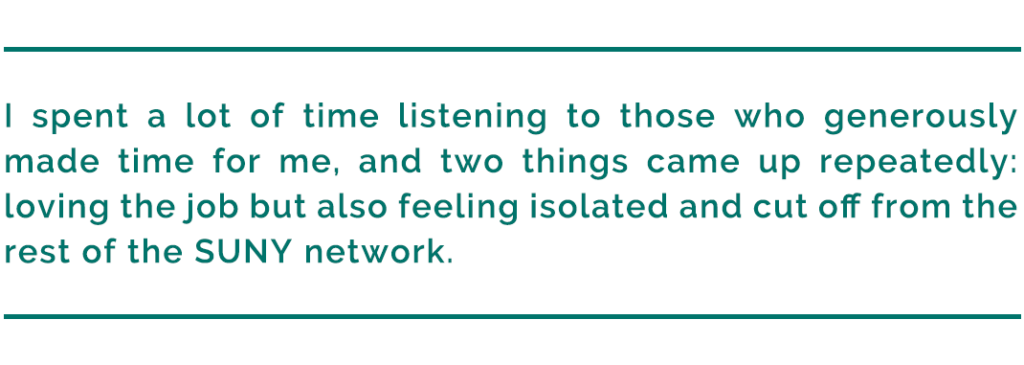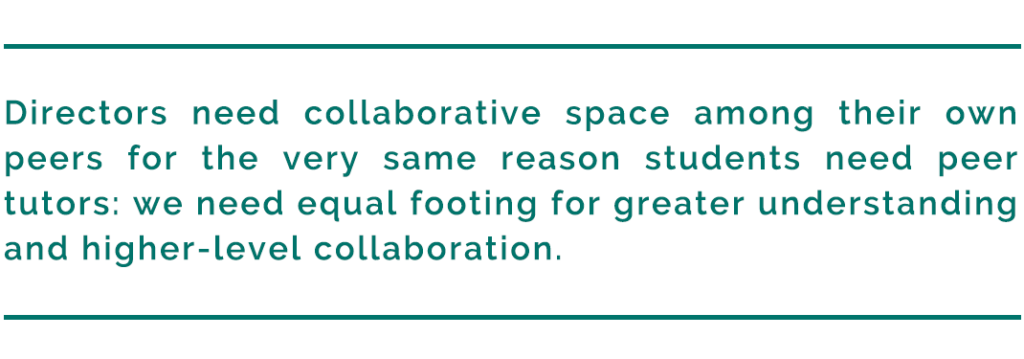By Khristeena Lute, SUNY Adirondack
Like many newly minted writing center directors, when I stepped into my first role of Director, I envisioned a hive of activity in this new-to-me center, with engaged conversations about tutoring, connecting with local campuses and their writing centers, and general collaboration all around. I made headway in other areas of my scholarship—literary criticism, creative nonfiction, and even a novel—but I still hadn’t quite found my writing center niche.
Instead, I faced one emergency after another after another (family tragedies, pandemic shifts, and the daily challenges that fill our email inboxes)—with each one leaving me feeling smaller and quieter. I kept my head down and focused on keeping my tutors working and the clients coming in, and before I knew it, eight years of triaging the daily had gone by—no research niche, no collaborations, no further along on my writing center path than when I started (or so it seemed to me).

In my eighth year in my role at SUNY Adirondack in upstate New York, I applied for and was granted my first sabbatical—two semesters at half-load so I could focus more deeply on writing center studies. My official sabbatical goals were to design and implement an assessment plan for our center—the Center for Reading and Writing—and to expand our tutor training program. Through my rose-colored glasses, I thought how great it would be to tap into the SUNY network, organize collaborations, share resources, and visit each other’s centers—even connect our tutor training courses! I began reaching out and received very few responses at first—and finding two-year community colleges that still had a full-semester tutor-training course like ours felt like searching for a unicorn.

It turned out, many centers had had high staff turnover rates, especially since the pandemic, and many of the contacts I had reached out to had already moved on. When I did find currently placed WCDs, I quickly set up zoom chats, detailed email exchanges, and campus visits.

I spent a lot of time listening to those who generously made time for me, and two things came up repeatedly: loving the job but also feeling isolated and cut off from the rest of the SUNY network. Our SUNY educational system has 64 campuses—64!—so why are so many of us feeling so alone?
The Schrödinger Center for Reading and Writing
In writing center studies, we understand the truly liminal nature of what we do. Our centers are not classrooms, but they are still places of learning. Directors are often faculty and administrators—and in small colleges, where the role of the WCD is often the only one on a campus, they can also be payroll, tutor-trainer, HR, tutor, public speaker, workshop presenter, liaison to This-That-and-the-Other, assistant director, tech support, facilities support, marketing and social media expert, and even receptionist—as well as carry a course load with committee and service responsibilities. And that list only covers the day-to-day efforts; as writing center practitioner Mary McDonald writes, in addition “we must find time to read journals (Eodice, 2015), to conduct research (Frizzle, 2019; Teller & Denny, 2013; Wynn Perdue and Driscoll, 2017), and to accurately describe our duties (Caswell et al., 2016)” (164). As WCDs, we are everywhere—and somehow seemingly nowhere—at the same time, rendering much of our work—or sometimes maybe even our campus existence—invisible.

And yet, when we do read the journals, conduct the research, and attend the conferences, many of us only see how much more we need to learn before we feel we can be “ready” to participate (thank you, Dunning-Kruger Effect). We wait for someone else (a “real” adult, if you will) to grant upon us the validation of being “ready”, but when you are the only one doing something on your campus, there is no one to nudge you. And last year, I finally saw it—oh horror of horrors!—somewhere along the way, I became the adult. If I wanted to be a part of a network and connect with other SUNY centers, and it turned out there was no network, well…I’d have to start that network.
Cross-Institutional Collaboration—Isn’t that just conferencing?
Over and over again, I listened as directors spoke about how much they loved their jobs, their tutors, and their centers—along with how they wanted to connect to other center directors. Unless we’re at a conference, there’s little collaboration or conversation with other WCDs, and even there, we share a tiny bit, ask a question or two, and move on, often overwhelmed by information (or maybe that’s just me?).

Like the participant in Anne Geller and Harry Denny’s 2013 study, I often leave writing center conferences feeling as though I, too, was “on the outside of academic culture looking in, yearning to contribute and complicate conversations that often advance without their active participation, yet lacking incentive, opportunity, or tools to do so” (118). And that’s even if we’re able to go to a conference at all.
Many WCDs are in roles as staff or contingent faculty, or they are at smaller institutions where travel funding is limited, if it exists at all, thus “it may be necessary to take a broader view of how to professionalize within writing center administration” (McBride and Rentscher). And yet, as helpful and (financially and physically) accessible as online conferencing can be, it can be difficult to develop the same rapport or networks as in-person conferencing can. So where does that leave us?
What about mentoring?
Much can be and has been said of mentoring in writing center studies, and many strong mentoring programs exist. Participants have extolled their value (McBride and Rentscher), and if the opportunity arises, participation in such programs can be beneficial to novice directors. Traditionally, mentoring programs are structured in a top-down dynamic with one mentor serving as the lead.

But what we really need is collaboration with those in similar roles or positions. Much like what we extol to our student tutors, WCDs need that same collaboration and exchange that we encourage in our centers. Because of our singularity and often sole-position on a campus, most of us simply do not have the opportunity, the platform, or—often—the time to exchange thoughts or ask another WCD the questions we really want answered: If I have to fire a student tutor, does that mean I failed as a director? How on earth do I break into the scholarship side of writing center studies? How did you get your tutor-training course through the SUNY silo system?
Directors need collaborative space among their own peers for the very same reason students need peer tutors: we need equal footing for greater understanding and higher-level collaboration.
When we train our student tutors, we often require them to conduct observations. We know the value of a strong, reflective observation, and as writing center practitioner R. Mark Hall writes, “[n]ot only do tutors observe one another at work, but also, more importantly, they discuss and reflect at length on their experiences afterward. In this way, novices accumulate multiple images of tutoring” (25). Now, imagine the amount of growth we as WCDs could experience by practicing the same exercise in other centers. If, as Hall contends, “writing centers ought to make direct observations a centerpiece of our work….ubiquitous and central to ongoing tutor education and program development” (26), then what growth and gains could result from extending the observable space beyond that of our own centers? If “GOOD OBSERVING = GOOD TUTORING” (Gillespie and Lerner 72), then surely an expanded viewpoint could lead to better directing?
Side Quest—But Wait! There’s More!
Through my sabbatical year, I shared my progress, challenges, and details about my chats and visits with my student-tutors, and I noticed a shift in them: more scholarly interest in the field itself. When we were invited to a half-day event at a large university (another result of reaching out to regional centers), our student-tutors got to experience what I had been all year: peeking into another center.

And what they saw, as student-tutors from a community college, was that they belonged there—that they were more than capable of participating in this field on a larger scale than our own small center. And when we hosted the assistant director from another university, the same result occurred: the larger academic world became a little more accessible. One peer tutor wrote, “I learned so much about myself as a tutor and as a member of our academic community. The event helped solidify my love for helping others and connected me to others who felt the same way….Overall, the event helped me understand who I want to be as a tutor.” Another felt similarly: “It made me much more confident in my writing center theory and practice.”
A third tutor relayed to me that her tutoring philosophy had been challenged but in a good way: “I think that going to the event opened my eyes to how much differently a ‘community college’ treats their peers. I wouldn’t say that our college is very competitive, but I enjoy that aspect of it. We lift each other up, especially within our CRW….I noticed that the other tutors found the need…to establish that hierarchy, which does not reflect my tutoring philosophy, or that of our tutoring center either.” Observing different tutoring philosophies in action not only demonstrated the existence of very different tutoring concepts but also enabled this tutor to find increased confidence behind her own ideas of writing center theory, which again led to a greater sense of belonging.
We know that a sense of belonging and community are major aspects of student retention and transfer success, but when that writing center community has already been introduced, it becomes a bridge. And, frankly, If the only benefit from my year of effort is that my TYC student-tutors find their footing as they transfer to larger schools in pursuit of their goals, then the effort is well spent.
Community of Practice
What I’ve inadvertently stumbled into this year is the formation of a community of practice, and I am full of hope for the connections and lessons I have in front of me now. In the span of less than a year, I find myself now serving on the SUNY Council on Writing (CoW)’s executive board and hosting the SUNYCoW Conference on October 24-25, 2025, in Queensbury, New York (Call for Proposal link). Listening to the needs of WCDs, particularly other TYC, I volunteered and now serve as the TYC Representative on the steering committee for the Northeastern Writing Center Association (NEWCA). I then set up a shared space for WCDs through the SUNY Brightspace D2L system, so we could begin to connect and learn from each other (and for those SUNY folks who are interested in joining, here is the Google form to request being added). Participation has been slow to start, but it’s growing.

The biggest lesson from this year, though—and the one I want to convey to all WCDs but especially those just starting out—is not to wait. You’re ready. Brand new to leading a writing center? You’re still ready to join a network and be a part of a community. Don’t know a soul directing anywhere geographically near you? Reach out anyway. Find your regional association, reach out on social media, or cold email the folks at institutions nearest you. Collaborations with closer-to-home institutions widen the writing center director’s circle and give them the roots and connection to find their own sense of belonging.
Finding Community
Here are some resources to start finding your own community:
- Facebook Directors of Writing Centers
- IWCA Affiliates Page
- SUNY Council on Writing (CoW)
- SUNY CoW Call for Proposals and Submission Form for the 2025 Conference, “Now What? What Now?: The ‘Writing’ Classroom after 2025”
- WCenter Listserv
- Have some suggestions for other community opportunities? Visit Khristeena’s Substack and leave a comment.
References
Geller, Anne Ellen, and Harry Denny. “Of Ladybugs, Low Status, and Loving the Job: Writing Center Professionals Navigating Their Careers.” The Writing Center Journal, vol. 33, no. 1, 2013, pp. 96–129. https://doi.org/10.7771/2832-9414.1758
Gillespie, Paula and Neal Lerner. The Longman Guide to Peer Tutoring, 2nd Edition. Pearson Education, 2008.
Hall, R. Mark. Around the Texts of Writing Center Work: An Inquiry-Based Approach to Tutor Education, UP of Colorado, 2017.
Jackson, Rebecca, and Jackie Grutsch McKinney. “Beyond Tutoring: Mapping the Invisible Landscape of Writing Center Work.” Praxis: A Writing Center Journal, vol. 9, no. 1, 2011. https://www.praxisuwc.com/jackson-mckinney-91
McDonald, Mary. “Renewal in Learning and Writing Center Leadership: Advice from Coaching Expert Richard Boyatzis.” The Learning Assistance Review, vol. 26, no.1, 2021, pp. 163–80.
Khristeena Lute completed her Ph.D. in 2016 from Middle Tennessee State University and is currently an Associate Professor of English and Director of the Center for Reading and Writing at SUNY Adirondack in upstate New York. She has received the SUNY Chancellor’s Award for Scholarship and Creative Activity and the SUNY Adirondack President’s Award for Excellence in Teaching. Her most recent publications include her upcoming novel, Whippoorwill Sing (2026); her debut novel, Finding Grace and Grit (2021); and “Katrina Trask: The Gilded Age of Philanthropy” (2023).


